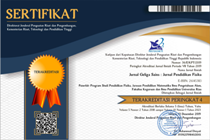HOW GOOGLE EARTH CALCULATES THE DISTANCE
Abstract
Google Erath is a very useful application in the field of geology, geography and even in the field of social sciences. This article is an explanation on how Google Earth calculates the distance of a location to another location. When a position above the surface of Google Earth is determined, the latitude and longitude and altitude will be visible. To be able to calculate the distance of two locations requires the conversion of both locations for latitude, longitude and altitude into position x, y and z, where z coordinates is the average elevation measured from the sea surface. This conversion uses the basic science of spherical geometry and coordinate system. By using the manual calculation between the Rector building of Univeritas Riau in Pekanbaru to Monas in Jakarta, the distance of two locations is obtained of 954,239.5 m. The result of the conversion and distance calculation with this concept shows the value of almost equal to the distance measurements made by Google Erath which amounted to 953,065.1 m with the difference of around 0.123%. For the other 4 locations the percentage difference is almost equal to the average of 0.173%.
Keywords
Full Text:
PDFReferences
Aleksandar Dragutinovic, Stefan Uitdehaag, & Irene Kuiper, 2014. A reply to: The transferability of diatoms to clothing and the methods appropriate for their collection and analysis in forensic geoscience, Forensic Sci. Int. 241 (2014) 127–137, Forensic Science International, Volume 247, February 2015, Page 25.
Andrew Jacobson, Jasjeet Dhanota, Jessie Godfrey, Hannah Jacobson, Zoe Rossman, Andrew Stanish, Hannah Walker, & Jason Riggio, 2015. A novel approach to mapping land conversion using Google Earth with an application to East Africa, Environmental Modelling & Software, Volume 72, October 2015, Pages 1-9.
Dougald J.W. O'Reilly, & Glen Scott, 2015. Moated sites of the Iron Age in the Mun River Valley, Thailand: New discoveries using Google Earth, Archaeological Research in Asia, Volume 3, July 2015, Pages 9-18.
Eduardo F.J. De Mulder, Wolfgang Eder, Aberra Mogessie, Enas A.E. Ahmed, Pauline Y.D. Da Costa, Ibouraïma Yabi, Eliud Mathu, Sospeter Muhongo, Sierd A.P.L. & Cloetingh, 2014. Geoscience outreach in Africa, 2007–2013, Journal of African Earth Sciences, Volume 99, Part 2, November 2014, Pages 743-750.
Feng Qi, & Yixiang Wang, 2014. A new calculation method for shape coefficient of residential building using Google Earth, Energy and Buildings, Volume 76, June 2014, Pages 72-80.
Hai Ha Le, Helmut Schaeben, Heinrich Jasper, & Ines Görz, 2014. Database versioning and its implementation in geoscience information systems, Computers & Geosciences, Volume 70, September 2014, Pages 44-54.
Halliday D., & Resnick R., 2011. Fundamentals of physics. Jear Walker.-9th ed.
Kasper Johansen, Stuart Phinn, & Martin Taylor, 2015. Mapping woody vegetation clearing in Queensland, Australia from Landsat imagery using the Google Earth Engine, Remote Sensing Applications: Society and Environment, Volume 1, July 2015, Pages 36-49.
Liang-feng Zhu, Xi-feng Wang, & Xin Pan, 2014. Moving KML geometry elements within Google Earth, Computers & Geosciences, Volume 72, November 2014, Pages 176-183.
Mladen M. Dordevic, & Steven J. Whitmeyer, 2015. MaRGEE: Move and Rotate Google Earth Elements, Computers & Geosciences, Volume 85, Part A, December 2015, Pages 1-9.
Nirav N. Patel, Emanuele Angiuli, Paolo Gamba, Andrea Gaughan, Gianni Lisini, Forrest R. Stevens, Andrew J. Tatem, & Giovanna Trianni, 2015. Multitemporal settlement and population mapping from Landsat using Google Earth Engine, International Journal of Applied Earth Observation and Geoinformation, Volume 35, Part B, March 2015, Pages 199-208.
Tooth, S., 2014. Google Earth™ in Geomorphology: Re-Enchanting, Revo- lutionizing, or Just another Resource?, Reference Module in Earth Systems and Environmental Sciences, from Treatise on Geomorphology, Volume 14, 2013, Pages 53-64, Current as of 4 August 2015.
DOI: http://dx.doi.org/10.31258/jgs.5.1.41-46
Refbacks
- There are currently no refbacks.
Copyright (c) 2017 Nur Islami

This work is licensed under a Creative Commons Attribution 4.0 International License.
Jurnal ini terdaftar dan terindeks pada:
- Crossref
- Google Scholar
- Crossref
- Garuda
- Sinta
- Researchgate
- Dimensions
- Base
- Scilit
- OneSearch
- Road
- CiteFactor
- ResearchBib
- WorldCat



















